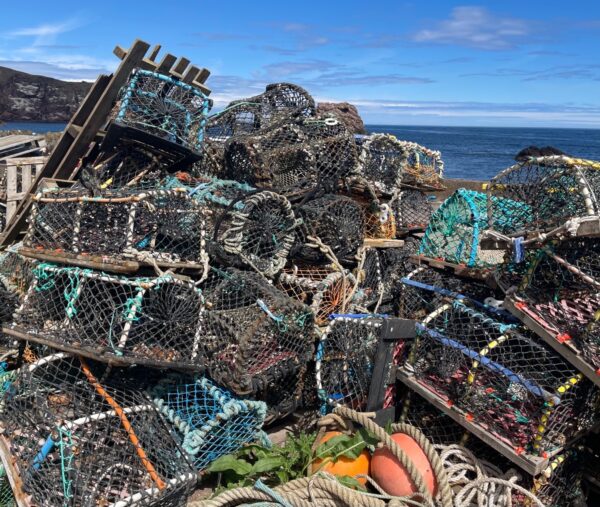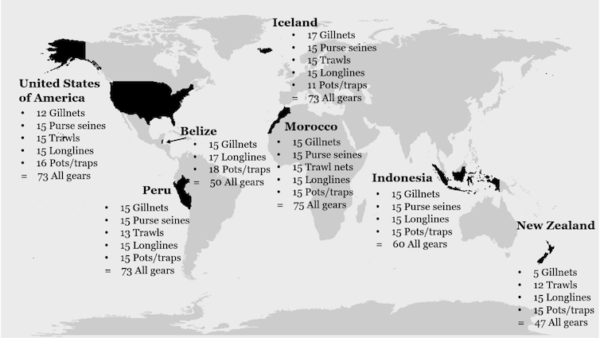Two per cent of all fishing gear used worldwide ends up polluting the oceans, new research finds. To put that into perspective, the amount of longline fishing gear littering the ocean each year can circle the Earth more than 18 times.
Researchers as CSIRO, the Australian government’s scientific research centre, found that 740,000km of fishing line and 14 billion hooks litter the sea each year. The following extract is taken from a piece in The Conversation by Britta Denise Hardesty of Australia’s CSIRO.
As part of the research, interviews were conducted with 450 fishers from seven of the world’s biggest fishing countries including Peru, Indonesia, Morocco and the United States, to find out just how much gear enters the global ocean. We found at current loss rates, in 65 years there would be enough fishing nets littering the sea to cover the entire planet.
This lost fishing equipment, known as ghost gear, can cause heavy social, economic and environmental damage. Hundreds of thousands of animals are estimated to die each year from unintentional capture in fishing nets. Derelict nets can continue to fish indiscriminately for decades.
14 billion longline hooks litter the sea each year
The data we collected came directly from fishers themselves. They experience this issue first hand and are best poised to inform our understanding of fishing gear losses.
We surveyed fishers using five major gear types: gillnets, longlines, purse seine nets, trawl nets, and pots and traps.
We asked how much fishing gear they used and lost annually, and what gear and vessel characteristics could be making the problem worse. This included vessel and gear size, whether the gear contacts the seafloor, and the total amount of gear used by the vessel.
We coupled these surveys with information on global fishing effort data from commercial fisheries.
Fishers use different types of nets to catch different types of fish. Our research found the amount of nets littering the ocean each year include:
- 740,000 kilometres of longline mainlines
- nearly 3,000 square kilometres of gill nets
- 218 square kilometres of trawl nets
- 75,000 square kilometres of purse seine nets
In addition, fishers lose over 25 million pots and traps and nearly 14 billion longline hooks each year.
These estimates cover only commercial fisheries, and don’t include the amount of fishing line and other gear lost by recreational fishers.
We also estimate that between 1.7% and 4.6% of all land-based plastic waste travels into the sea. This amount likely exceeds lost fishing gear.
However, fishing gear is designed to catch animals and so is generally understood as the most environmentally damaging type of plastic pollution in research to date.
Countries (in black) where interviews with fishers occurred. Fishers were surveyed from each of the seven key marine regions/continents of the world, excluding Antarctica. The number of surveys conducted for major gear types/fisheries are listed (bullet points) below each country name.
Harming fishers and marine life
Nearly 700 species of marine life are known to interact with marine debris, many of which are near threatened. Australian and US research in 2016 found fishing gear poses the biggest entanglement threats to marine fauna such as sea turtles, marine mammals, seabirds and whales.
Other marine wildlife including sawfish, dugong, hammerhead sharks and crocodiles are also known to get entangled in fishing gear. Other key problematic items include balloons and plastic bags.
Lost fishing gear is not only an environmental risk, but it also has an economic impact for the fishers themselves. Every metre of lost net or line is a cost to the fisher – not only to replace the gear but also in its potential catch.
Additionally, many fisheries have already gone through significant reforms to reduce their environmental impact and improve the sustainability of their operations.
Some losses are attributable to how gear is operated. For instance, bottom trawl nets – which can get caught on reefs – are lost more often that nets that don’t make contact with the sea floor.
The full piece from The Conversation can be read here and the peer-reviewed journal paper in Science is here.

